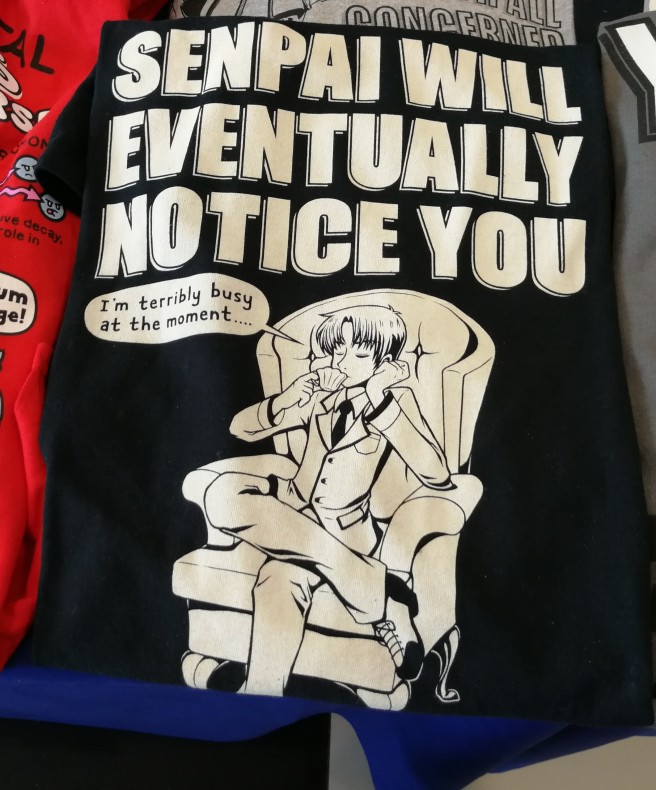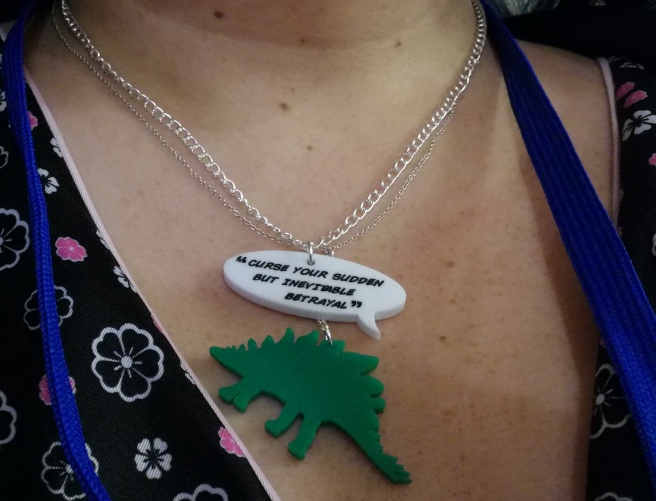 (T-shirt from Genki Gear)
(T-shirt from Genki Gear)
Note: apologies this has taken longer to write up and post than I had originally thought. Lack of sleep and anxiety are both bastards, but ones I’m starting to deal with again. So, onwards!
Prologue here
My first day at Nine Worlds (9W) started off hectic. As I said in my last post, we were travelling/checking in on the day 9W started, so I was already a bundle of nerves before we even arrived.
We got there reasonably early, around 9:00 am. This gave us more than enough time to register and get settled. The person on the registration desk complimented my dinosaur dress and asked if I was a big dino fan, which I am because of course dinosaurs are amazing. She told me the name of an author (which I stupidly forgot to write down) who was writing a book about time-travelling dinosaurs.
Suffice to say that, unless I can remember the name of the author, my Google search history is going to see the term “time-travelling dinosaurs book” crop up quite a bit in the future.
We were each handed a goody bag, containing our programmes, lanyards, flyers and a book. Yes, you get a free book – mine was Guns of the Dawn, by Adrian Tchaikovsky, and I’m going to be starting it shortly. Also included within were cosplay tokens – these are for attendees to hand out to cosplayers whose outfits impress them. For every 15 tokens handed in, the cosplayer gets a small prize. I remember giving mine to a miniature Luke Skywalker, the Glow Cloud from Welcome to Night Vale, a Lemming, Squirrel Girl and, of course, No-Face.
I then had the option to choose my overlay, pronoun sticker and lanyard colour. I went for the blue overlay (looking to engage in conversation) and blue lanyard; a yellow lanyard was for those who wanted to communicate they absolutely did not want to be photographed. It’s a small but effective change and empowers people to set their own comfort zones and requirements.
9W was held over several floors at the London Novotel West hotel, and the rooms were, from my experience, spacious and well set-up. The Tech Team would double-check mics and fix any technical issues before panels and presentations. There was priority seating outside and inside the rooms for those with access needs, in alignment with the inclusivity at the heart of much of what 9W does.
My first session was Podcasting 101, a talk by Matt Dillon, the GeekPlanetOnline Editor-in-Chief. GeekPlanetOnline is an online community and podcasting network which has been going since 2008. I found this to be the most useful session of the day, though all panels were informative.
Dillon’s talk was often funny, with humorous touches to his PowerPoint presentation. He also made sure that there were accessible copies of his presentation for those who needed it. The aim of Dillon’s talk was to give a rundown on how to set up a podcast with minimum equipment, and I gained a lot of information. I had no idea that I could use Audacity to edit, nor what hosting involved. I also had no idea I’d need album art to put a podcast on iTunes, but things like The Morgue File allows you to use photos for free as long as they are slightly altered. I came away with lots of notes, which I’ll hopefully be able to put into use soon (me and a couple of friends are setting up a podcast about films). However, if you’re looking to start a podcast about movies, games, anime, or general geekdom, hit me up! Dragon Age is a particular love of mine…
The next session was the Shut Up & Write panel, featuring Dr Tiffani Angus (senior lecturer & course leader), Dr Val Nolan (lecturer), and Angus Watson (author). The panel dealt with writer’s block, or rather the importance of putting that term aside and getting on with the task at hand. As a serial procrastinator, I was looking for some useful tips. The overall message was that there were ways to get around it, and you had to pick and choose what worked for you.
One helpful tip was that, if writing about a place, go visit it. They conceded that, if writing about New York, hopping on a plane to the Big Apple wasn’t exactly within everyone’s means. However, it was about at least getting out to a different space or location that evoked that same sensation. True, you can’t travel to a fictional fantasy land, but maybe you could go to a forest or a well-known place of oddities (Forbidden Corner comes to mind). The other very useful tip I came away with was using these questions to examine your goals, and to provide motivation:
- What project am I working on right now?
- Why?
- What will I have when I finish?
- What’s the big dream?
- What happens next?
The next part was about asking yourself what would happen if you didn’t complete the project, in terms of how you viewed yourself, your goals, how it would impact society, and on you professionally. The combination of this with visualising goals to drive you forward acts as an incentive to move past the block and just start writing.
Dr Angus mentioned that she was course leader on the MA in Creative Writing at Anglia Ruskin University in Cambridge. I believe it’s blended learning, with a lot of distance learning, so those wanting to hone their skills might want to check it out.
The next talk was Westworld: All the Feels, All the Thoughts, moderated by Tom Parker, featuring Samantha Jayne (Access Coordinator), Iris Fritschi-Cussens (artist), and Steph Rennick (lecturer in philosophy, who also wins extra admiration from me for having a Flemeth quote on her site). If you haven’t seen Westworld, I highly recommend it as it was a breathtaking piece of television. Also, some mild spoilers coming!
I didn’t take any notes during this one as I was there more for geeking out. What followed was a fun discussion about our favourite characters, how they grew and changed, and the twisty nature of the plot. The Funko Pop Westworld character statues sitting on the panel’s table were put to great use demonstrating their alive or dead status. I asked whether Robert Ford (Anthony Hopkins), given his actions throughout the show, was a bad guy or a good guy, a la Dumbledore. I believe the conclusion (apart from Dumbledore was a good guy!) was that yes, Ford was good, or trying to be. The means were brutal, but he was trying to honour his friend. I think I agree, but with a LOT of “buuuut”s.
The last panel was Twisted Tales: The Darker Side of Fairy Tales. Karen Graham acted as moderator, featuring Chris Wooding (author), Charlie Oughton (lecturer and journalist), Sandie Mills (researcher), and Jessica George (independent researcher). The session focused on the origins of the sanitised, Disney versions we have today. The discussion about The Little Mermaid hit me hard as I remembered that was one tale I had read in its original Hans Christian Anderson form as a child, before the Disney film came out. The real ending is a great deal sadder and darker than the film, and is why I never loved the Disney version as much as my childhood friends did; though the original was bleak, it was the first time I had experienced a story where happy endings were not guaranteed, and I liked it for that.
The talk covered how fairy tales had been collected, noting that whilst The Brothers Grimm are often seen as the original writers, fairy tales had been going for much longer. The term “fairy tale” was originally coined by Madame d’Aulnoy in the late 17th century, when these stories gained popularity in Parisian salons. The Grimms also removed all premarital sex, but kept or even ramped up the violence. No sex outside marriage, but gory details, like slicing off toes or heels to fit a slipper, were seen as perfectly acceptable. My favourite fact was finding out that the ending of Snow White had the evil Queen dragged to Snow’s wedding, with her feet then encased in red-hot iron shoes. The Queen was forced to dance until she dies in agony. Makes the waltzing scenes in the Disney films just a little unnerving, now.
I think the only problem I had with the panel was that it covered quite a bit that I already knew. Having had a fascination with the darker side of storytelling for a while, I may not have been its intended audience as I was aware of quite a lot of what was covered. I think I might have enjoyed this more as a one-person presentation, where a bit of history was given, but then direct comparisons made between the original versions of several fairy tales versus their newer incarnations. The subject felt like it didn’t need a panel discussion, and perhaps instead more structure, though it was well-moderated. However, that would have just been my preference, and I believe that many in the audience got a lot out of the discussion as it was.
I think the only real bum notes for me were when one of the panellists arrived late and departing this a bit, the same panellist who, during Q&A, acknowledged they were not the best person to talk about a question (I think it was about representation), and then proceeded to answer it anyway. At. Length.
The last event of the day was the one I had been looking forward to most: the Videogame Burlesque! I want sure what to expect, but I was pleasantly surprised at the diversity of performers. The Bioshock Big Daddy strip tease by Artemis Queer (AKA Tab Kimpton) was sublime. Sadly, I didn’t get the game reference from John Celustus’s performance, but as I overheard once adoring fan tell John later, he looked like a literal piece of art. The show featured homages to Princess Peach, Watchdogs, with a special shoutout to Tanyisha Rusbridger for an outstanding Grim Fandango-themed performance.
It would be remiss of me not to mention some criticism I saw about part of the show. There were several angry tweets on Twitter during and after the show about a section where a performer dressed and stripped as Chop Chop Master Onion from the PaRappa the Rapper game. There were accusations of reinforcing Asian stereotypes, particularly as there was a segment of audience participation before it, where audience members had to play the Chop Chop part of the computer game to win prizes. I’m mixed race, with Asian heritage. However, I also did not initially understand the implications of using this character. After thinking about it for 5 seconds, I realised that this was of course a harmful stereotypical character, and one who really didn’t need to be used. I doubt that the segment creators thought it would cause offence, either. I think what is important, though, is that it did, and that those affected raised valid points which should be discussed.
9W day one was over, and I left feeling more energised and enthused than when I started. Day 2 would, of course, bring its fair share of surprises and randomness…

